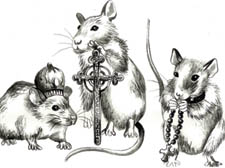|
|
 |
| |
Did you ever hear such a thing in your life?
In an entertaining and lovingly researched new book that uncovers the facts behind nursery rhymes, Gerald Isaaman discovers the true identity of Old Mother Hubbard and learns how Little Jack Horner had his sticky fingers in the property business
Pop Goes The Weasel: The Secret Meanings of Nursery Rhymes. By Albert Jack. Allen Lane £12.99
JACK and Jill went up the hill to fetch a pail of water… or did they? Children have long been taught this traditional nursery rhyme, but is it purely the nonsense we all suspect it to be? Moreover, is it even British?
Xenophobes will be pleased to know that it is possibly all about Louise XVI and his infamous queen, Marie Antoinette, who came tumbling down, losing their crowns, facing the guillotine of the revolution in France back in 1793.
Or it could have originally emanated from the Somerset village of Kilmersdon, where an unfortunate unmarried couple, expecting a baby in 1697, died tragically – Jack from a rock that fell off a hill and Jill in childbirth.
These two solutions – and there is a third involving Shakespeare – come from a fascinating little book of intriguing tales which is filled with unexpected delight in revealing the mysteries behind the seemingly simple rhymes that still keep children amused in their cots.
Author Albert Jack, who sounds like a nursery rhyme himself, spent 10 years delving into the history of idiosyncratic riddles and rhymes, ranging from Baa Baa Black Sheep to Wee Willie Winkie, and some traditional songs and anthems too like Jerusalem and Yankee Doodle Dandy.
Humpty Dumpty, he discovered, was the name of one of King Charles I’s cannons located on top of a church tower at the Siege of Colchester during the Civil War in 1648.
“Operated by one-eyed Thompson, a Royalist gunner, it successfully kept Cromwell’s forces at bay until the Parliamentarians managed to blow it off the tower, allowing them to take over the town,” he reveals.
The Three Blind Mice turned out to be the Oxford martyrs Hugh Latimer, Nicholas Ridley and Thomas Cranmer, all burned at the stake for their faith, by the Farmer’s Wife, alias Mary I.
No wonder he found the research the best part of the process when he was introduced to such characters as the 16th-century spider expert Dr Thomas Muffet and his daughter, Little Miss Muffet, and unexpectedly found that Old Mother Hubbard was in fact Henry VIII’s arrogant advisor Cardinal Wolsey.
Little Jack Horner is Albert Jack’s personal favourite. In reality, he was Thomas Horner, who was sent to see Henry VIII with a bowl full of property deeds disguised as a pie in an attempt to bribe the King.
However, on the way to London from Glastonbury, Horner reached into the pie and stole a plum piece of real estate for himself – a place called Mells Manor – just like today’s banking barons, who have deceived us so mercilessly. What’s more, the current descendants of Thomas Horner still live in Mells Manor.
So here is some sound proof that nursery rhymes aren’t exactly innocent songs for children to sing and recite but slices of social history whose origins have long been forgotten, among them the gay goings-on centuries ago.
Georgie Porgie, unbelievably, is about George Villiers (1592-1628), the handsome nobleman who became Gentleman of the Bedchamber in the court of James I, and did well for himself. He was made an earl, then a marquess, and, at 31, the first Duke of Buckingham, thanks to his close association with the king.
“The nursery rhyme is said to mock both James I and George Villiers over their open romantic interest in each other,” reveals Albert Jack. “In fact, the king even proclaimed to the Privy Council that ‘You may be sure that I love the Duke of Buckingham more than anybody else’.”
An Apple A Day, on the other hand, is not some ancient apple industry promotion but an attempt to get children to eat their greens, a problem still with us today.
“As for proving the
origins of each rhyme, I have searched high and low, near and far, in an attempt to root out the definitive answer – or as near definitive as possible,” Albert Jack explains.
“Sometimes I have agreed with previous researchers and at other times feel they may have missed vital information, but, by and large, where I have arrived at two or more possible conclusions, I have presented every option, leaving it to the reader to make up his or her mind.
“After all, this book has not been written to start arguments in the pub about nursery rhymes. It is simply meant to be a bit of fun and give us something to talk about with friends and family.”
On that score – and Pop Goes the Weasel was a highly popular song in Victorian days about the worst excesses of the rag trade – it certainly succeeds triumphantly.
|
| |
|
 |
 |
|
 |
|


